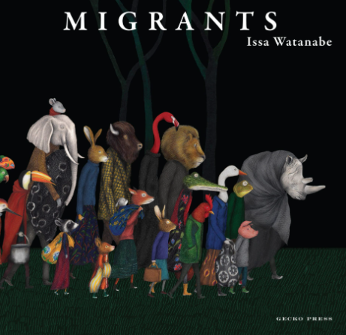I am thinking a lot about silent picturebooks these days as the Waikato Picturebook Research Unit approaches its annual picturebook seminar (November 12, 2020), this year focusing on silent picturebooks (https://www.ivvy.com.au/event/7GKY2K/). My usual focus when I research picturebooks is the languages used in multilingual picturebooks, so it’s really good for me to be thinking about the power of picturebooks which use illustration alone to tell their story. The absence of a written language means that all (sighted) readers can follow the story, telling it in their own language if they wish, and this is the reason for the creation of the IBBY silent picturebook collection which now travels the world, and reflects the work IBBY has done in establishing a library in Lampedusa, Italy for local and refugee children. Between November 2-27, 2020 the IBBY Silent Book Collection will be on display at the University of Waikato Library, and members of the public are welcome to attend.
I’ll share one book below, and then please follow the link to read my other recommendations.
I found this book with its Spanish title Migrantes at the Guadalajara Book fair in December 2019 and then discovered that Gecko had bought the rights to publish it in English as Migrants (2021). The story begins as we are introduced to a skeleton draped in floral cloth beside a large red beaked Ibis bird (a messenger between birth and death). The skeleton joins a group of anthropomorphised characters of various shapes and sizes, adults and children who are moving together through a gloomy forest. We know from the title that these are migrants; we know from the faces and clothing that this is not migration by choice- these are refugees with death (symbolised by the skeleton) close at their heels. The Peruvian author Isse Watanabe has said that her book is about empathy and through its pages we witness the journey of this group with insights into the experiences of refugees. We see the group move through a forest and then reach a body of water where they scramble into a boat and cross, losing a member along the way. Finally they come to a place where the trees have colour and there is a fruit on the ground- which I interpret as a symbol of hope. This book deals with complex topics including courage, loss and hope, and the images do this sensitively and powerfully.

The power of the silent book lies in the illustrations and how each reader is allowed to create their own words around those images. This brief snapshot of one of my favourites shows that they can deal with very sophisticated and complex issues. They offer opportunities for interaction and meaning negotiation for a parent with a child, and a classroom teacher with a whole class.
To read my other recommendations including Raymond Briggs’s Snowman, Molly Idle’s Flora and the Flamingo, Aaron Becker’s Journey, Shaun Tan’s The Arrival , Jeannie Bakers’ Mirror and David Weisner’s Flotsam, please fo to the Gecko Press Blog. https://geckopress.com/book-list-wordless-picture-books/
Nicola Daly
